Mark Twain said, “The only way to overcome public speaking fears is to speak in public.”
If you’ve ever felt your heart racing and palms sweating at the mere thought of standing in front of a crowd, you’re not alone. Did you know that public speaking is one of the most common fears in the world?
According to a National Institute of Mental Health study, about 75% of people fear public speaking. Did you know that the fear of public speaking, also known as glossophobia, studies have shown that more people fear public speaking than they do death itself? It’s a fascinating phenomenon highlighting how deeply this fear can impact us.
But you know what’s even more fascinating? Countless stories of individuals have faced this fear head-on and emerged victorious. Many famous and successful people have also been afraid of public speaking at some point in their lives. For example, Steve Jobs, Bill Gates, and Oprah Winfrey admitted to being terrified of public speaking before becoming successful.
Introduction
Friends, Public Speaking, is such a word that most of us are very scared of. How to talk to people? How do you speak on stage with confidence? How to record a good video for social media? With full confidence. Without cut. How do you talk in an interview? How do you talk to the boss for appraisal? How do we propose for marriage?
For all these things, being proficient in public speaking is very important. Remember that person whose way of speaking you like very much. His public speaking best was amazing. And you also want to talk to millions of people like that person. I want to positively influence them. If all this is happening in your mind, then today’s video can be life-changing for you.
Today, we will discuss “The Art Of Public Speaking” Book, written by Bestselling Author Dale Carnegie.
To understand this book better, we have divided it into 12 chapters. So let us know each one in detail one by one.
Chapter 1. Speaking in Public
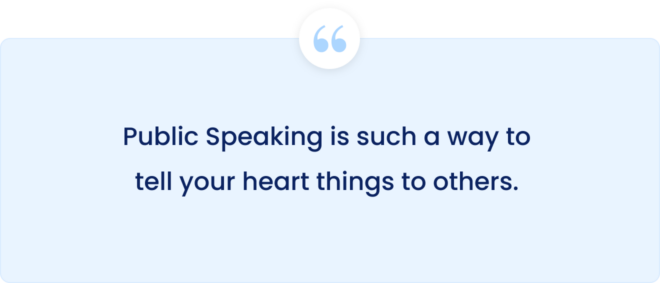
Public Speaking is such a way to tell your heart things to others; in earlier times, when people could not speak, they used to convey their thoughts by writing. First of all, this method came about 450 years ago in Egypt, when people used to tell each other their words by writing, but with time, people learned the language and then learned to use it to convey their words to others.
This process is called conversation; public speaking is different from it. Talking to one person is called conversation; when you say something in front of many people, it is called public speaking. When conversing with someone, you can say whatever is in your mind, and there is no particular need for planning; you can also use your daily colloquial words.
In public speaking, you must plan what and how to say it. Here, instead of colloquial words, formal language has to be used. Here are some things that we should keep in mind while doing public speaking,
- We have to understand the argument of our audience and their feedback; we cannot do that, keep telling our things and not listen to the audience. In such a situation, the audience will lose interest in your speech. For this, keep taking time to time for feedback from your audience.
- Connect emotionally with the audience and keep your words with facts.
- Whatever message you want to give through your speech, reach it clearly to the audience.
Chapter 2. Ethics and Public Speaking
Public speaking aims to get the desired response from the listeners, but not at any cost, meaning if the listeners have liked your talk, they will only clap for you; you cannot force them to clap a little. Public speaking is like a power, so many responsibilities are associated.
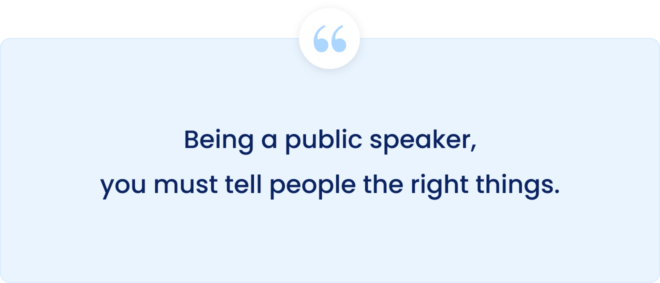
Being a public speaker, you must tell people the right things, but some people misuse it and give wrong knowledge to people by taking advantage of their skills in the greed of money or any other thing. By manipulating people with their words, they make people believe yes for their purpose. The ethics of public speaking says that if you do not know anything or have no specific knowledge about a subject, do not tell others and first learn yourself, then tell others. And never tell a lie.
Chapter 3. Listening
What comes to your mind when you hear the word listening for the first time? It might mean hearing, but listening and hearing are two different words. Listening means listening to anything and then giving your reaction to it, whereas in other words, hearing means just listening to something and giving the response that comes to mind. Both these words have different meanings.
When you are talking to someone and listening to their words, you will call it hearing where you are saying your words and listening to the person in front. When you do public speaking or sit in front of a public speaker as an audience, you do listening, which means you keep every little word and every little thing in your mind and try to understand it. And after that, give your reaction.

To be a good speaker, first of all, be a good listener. It has been found in the research that we can remember only 50% of what we hear. This is because we often want to speak before listening, so our mind gets divided in two directions, and we cannot concentrate 100% on any one thing.
Therefore, to become an excellent public speaker, it is essential to understand your audience. Whenever your audience says something to you, you must be entirely silent to understand them well. Do not just keep saying your words and not understand their words, or if you are going as an audience, listen to your public speaker first and then tell your comments so that both of you can know each other better.
Chapter 4. First Speech delivery method
For a public speaker, his first speech is critical. When you give your first speech, you will become a public speaker to the audience and have yet to gain experience. Therefore, here, the author has given some methods; adopt them for your first speech.
Interacting with audience
Talk to your audience because if you start with your topic as soon as you go, no one will enjoy and be interested in your speech. By talking to the audience for 2 or 3 minutes in the beginning and asking them about their well-being and the purpose of coming here, they will like your behaviour. They would like to listen and understand your words carefully.
Focusing on your topic
After talking to your audience:
- Focus entirely on the subject.
- Gradually tell people about your topic.
- Only say to the audience what is necessary.
If your topic is related to science and you tell people about deep science more than the science of daily life, then people will not take an interest in your talk, and their interest will end in your speech simultaneously. Keep people connected with your words. Use colloquial formal words in your talk; do not use heavy words so everyone can understand it and the audience stays associated with you.

Organizing the speech
Plan your speech thoroughly and speak. It is necessary to do the planning so that it is clear what thing speaking first will have a good impact on the audience and what should speak later. Start with the introduction first, then gradually move to the main body of your topic. Try to cover every vital part of your topic in the main body, and after that, while giving the conclusion in the last, complete it by telling the advantages and disadvantages of your topic; in this way, your speech will be organized entirely, and people will also enjoy listening.
Chapter 5. Selecting Topic
Remember, while selecting any topic for your speech, you should know that topic well or be new to everyone. Like, if you know very well about electric vehicles. If you know everything from making them to launching them in the market and buying them, you can tell the public very well.
Cryptocurrency is new for many people, and everyone wants to know about this topic. To extract knowledge about it, understand and tell it to the public, they would like to hear it, because it is a very new topic and everyone wants to know about it. If you don’t know much about a topic and the audience is a bit experienced, just cover the overview. This will maintain balance.
Chapter 6. Analyzes the audience
Before giving a speech, you must understand your audience and what they want. If people are sitting in your audience who are unhappy with married life and want to enjoy a happy married life, they will feel connected with you by talking about the reasons for this happening, its influence, and ways to fix it. If possible, share your personal experience related to this with them.
To find out the interest of your audience, first, talk to them and ask them where it is from. What is the purpose of coming here? You will know their mentality and what they want to hear by speaking a little talk like this.
Chapter 7. Support your ideas and speech
Along with preparing your speech, using some supporting things builds trust, and people can better understand the meaning of things. Supporting material means everything that makes the address even better.
For example, suppose your topic is electric vehicles. Many people will know about it, but if you take a picture of an electric car or make a PPT related to it on your laptop, people can understand it better.
So, you will take more interest in your speech, and things will be understood better. With this, keep asking questions to your audience during the speech, answer them, or ask someone from the audience to answer them.
Use physical examples
Now, talk to your audience and find out what the response is whether they have a positive or negative approach towards the speech. If their answer is good, then call some of them onto the stage and ask them to do a small task related to your speech in a funny way. This makes the audience feel good, and they can relate well to the speaker’s words.
Tell a story or incident
Let’s take an example for this: suppose your topic is related to Indian culture; then, to explain it, you can share your old story or tell a related story, which will arouse the interest of listening more in the mind of the audience.
Use numerical data
With data, we understand things in a few moments and start building trust, so keep showing your words verbally and showing data for support. By hearing only verbally, people remember that thing for some time, while data like graphs or diagrams is understood more clearly.
Use motivational quotes
By inserting some motivational quotes from time to time in the speech, the audience remains motivated and, without getting bored, starts paying attention to the speaker’s words again.
Chapter 8. Organize the body of the speech.
At this point, you will learn how to organize your speech well so that you can explain your topic easily from start to end. If you say anything in your address, you will need help understanding your point, so it is essential to organize your speech. Now, here are some techniques through which you can organize your speech.
Start with a light conversation and introduction.
While starting your speech, first talk to your audience and find out how they feel and think about this speech topic. After that, start telling little by little the smallest part of your topic and which should come first.
While telling, we also have to ask the audience some questions so they get interested in the topic from the very beginning. Remember that go only a little deep in the front. Talk a little, interact with the audience, and make a connection.
Follow the spatial order
After giving a small introduction in your speech, you now have to come to the main body of your address, where you have to go deep about your topic. For this, Follow the spatial order method.
This order means following a sequence to tell the facts. For example, if you are talking about the goodness of something, then talk only about its worth, shortcomings, and how to correct them.
Keep main points separate
All the important points in the speech and based on which the whole speech will be prepared have to be kept separate, and their examples must be kept separately. If you mix both together, the audience will not understand what is more important and what is not, what they should pay more attention to, and what is less. That’s why keep your important points separate from other examples; by doing this, you can say your speech effectively.
Chapter 9. Beginning and Ending of speech
By now, you have understood that we must start our speech with a light introduction. Here are some additional methods that can prove helpful in making the beginning and end of the address attractive.

So for this, follow these methods:
Connect the topic with the audience
For this, please give them a little introduction about your topic, then ask them some questions. After getting the answer, ask other questions from the audience by saying some things related to their talk so that they understand what today’s topic is about. It is about to happen, and the audience should be mentally prepared for it.
Start with a quotation
After the introduction, the first thing is to start your talk with a famous line or famous quotation so that people feel motivated and start taking an interest in the speech.
Tell the story
Since childhood, we have liked to listen to stories, and the things learned from the story go directly to our subconscious mind. So, after giving the introduction and saying a motivated line, narrate an incident or story related to the speech to the audience.
Use audio equipment or visual aids
After telling the story to our audience, we have come to the main body of our speech, where we discuss our address. During this, instead of explaining your words only by speaking, show photos or videos related to it.
Summarize your speech
Now you have finished more than half of your speech, and you have to move towards the ending, so you start reducing your address slowly and asking more questions from the audience. So that they understand that your speech is about to end and can answer you accordingly; by doing this, you can also make the end of your address enjoyable.
End with a quotation and good luck
After you finish your speech, you have to give a motivated quotation again like the beginning so that people feel motivated even while leaving and wish them good luck so that they take a good image of you in their mind and be ready to come next time again in your speech.
Chapter 10. Speech Outlining
So far, we have seen how to deliver a speech in front of an audience. Now you are going to know what are the things to keep in mind when you are writing a speech for yourself. And how can we write a speech so that everything is clear and becomes an exciting speech?
Here are some points for writing a good speech:
Preparation outline
When a speaker goes on stage and speaks, it is not just written on paper; everything is written about when to tell which line, what is the introduction, what is the main body, and what is the ending. When to give an example of what, when to ask which question to the audience, and where to speak again. We call this process preparation outline.
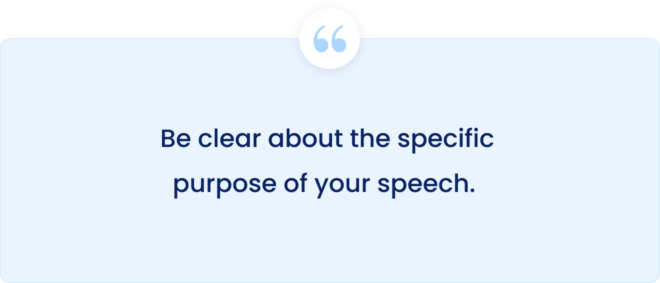
Now, let’s see how you can prepare for the outline.
Be clear about the specific purpose of your speech
For this, you have to remember what to give in the most important part of your speech, i.e., the main body, or you can understand it in another way that we have to keep the title of our speech. We have to write what our speech will be.
If the speech is about a country, then first of all, write the name of that country and extract everything online or whatever resources you have. This is part of our first step, where we have to decide what the title of the speech will be and what the address will be on this topic.
Label the introduction, body, and conclusion
Now, after deciding the title of your speech, you have to see which part of the speech we have to put in the introduction, which amount to put in the body, and which position to put while ending the lesson.
Because if we do not decide well when we have to speak, our whole speech can go back and forth, and the audience will not understand anything. Everything has to be said at the right time to be understood to keep the audience’s interest.
Use the symbol
Maintain a flow throughout the whole speech; it should not happen that you say something else first and then start saying something else, due to which our words go wrong and leave the audience interested.
For this, you have to keep in mind that if we are coming by telling the goodness of something, then still we have to disclose its good; if there is something wrong about it, then first we have to complete the good thing, after that, we should say something wrong about it.
So that the audience can understand what is being said well and when wrong. Mixing the two won’t make them know what you’re trying to say, and they’ll lose interest.
Chapter 11. Use Language Smartly
Your speech language should be clear and connected to the audience. The language here means in which tone you are speaking. Remember, whether your words are being misunderstood by the person in front of you or what you are trying to say is written correctly, you need to be able to speak better.
Speak comfortably during your entire speech; speaking comfortably does not mean speaking slowly. There may be something in the topic that you do not like, so in that influence, you can talk negatively while speaking it, due to which some people may get angry with you.
That’s why you have to say only what you have written or what is the fact. If real things can hurt someone, keep your words like this so that the audience does not feel bad and understands the meaning of your talk.
Chapter 12. Delivery
By now, you have understood how to write your speech. What are the things that must be there at the address? Which language to use? How to keep your audience engaged- what to say continuously so that our audience will be interested in the speech.
Now, we see the essential thing while speaking a speech, which is the delivery method. Yes, the way of delivery means the habit of saying or telling anything. Think for yourself: of all the public speakers you have seen to date, have you ever noticed that they are saying something with laziness? Whatever they say, they speak with enthusiasm and full consciousness. Due to this, the influence and trust of their words start increasing.
Follow these methods to improve your way of delivery:
Physical appearance
Person appearance, i.e., in what way any person comes in front of you; think about it, if you are going on the stage wearing only shorts and a T-shirt for the speech, will the person in front take you seriously or will he believe you? No, because you did not appear before him how they wanted. Whenever we think of a public speaker, a gentleman wearing suit boots comes to us. So you also always go for your speech being the same gentleman. Or at least wear formals.
Gestures – Movement of the speaker’s hands and shoulders during a speech
Getting ready by wearing a suit has done the first thing right now, to focus on the second skill, take care of your body posture and hand action. Keep changing your body moment according to the speech.
For example, instead of giving a motivational address by just sitting on a chair, standing up to give a motivational speech, opening your hands together with people, asking them some questions, giving some answers to them, and speaking your speech, the audience will be interested, they will listen to you. Will be able to understand and believe.
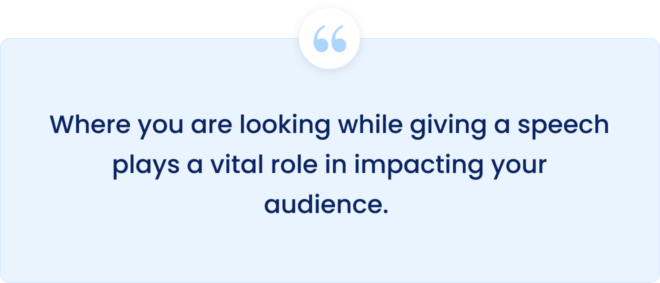
Eye contact
The third most important thing is eye connection. Where you are looking while giving a speech plays a vital role in impacting your audience. Pay attention; you are not looking at any wall, fan, or speaker. If you are seeing this, then it shows nervousness. It shows that you lack confidence. With this, the audience will be unable to believe you and will not be interested in your speech. That’s why you always look into the eyes of your audience while giving an address so that it shows confidence, increasing your faith and interest among the audience.
Conclusion
So, friends, in this video, you have learned the art of public speaking to confidently convey your words to others. Let us now recapitulate the lessons learned once so that it becomes easier to remember these lessons:
- Keeping in mind the interest of your audience, keep preparing the speech and take time to time for feedback from your audience for this.
- As a public speaker, you must tell the right things to the people.
- To be a good speaker, first of all, be a good listener.
- Keep people connected with your words. Use common colloquial formal words in your talk.
- Plan your speech thoroughly and speak. It is necessary to do the planning so that it is clear that speaking first will have a good impact on the audience and later.
- Remember, while selecting any topic for your speech, you should know that topic well or be new to everyone.
- Along with preparing your speech, using some supporting things builds trust, and people can better understand the meaning of things. That’s why support your address through examples, stories, data, or motivational quotes.
- Start with a light conversation and introduction.
- Connect the topic with the audience.
- After the introduction, the first thing is to start your talk with a famous line or famous quotation so that people feel motivated and start taking an interest in the speech.
- Be clear about the specific purpose of your speech.
- Label the introduction, body, and conclusion so that it is clear to the audience when the opening is being told and when the main thing and the ending are happening.
- Use symbols to explain your points better.
- Improve your delivery, take care of your physical appearance and gestures, and interact with the audience. Talk by making eye contact.
The Art Of Public Speaking Book Review
“The Art of Public Speaking” by Dale Carnegie is a timeless masterpiece on effective communication.
Carnegie’s insights, drawn from years of experience, offer invaluable guidance for aspiring orators. The book covers topics like confidence-building, audience engagement, and persuasive techniques, making it a must-read for anyone seeking to improve their public speaking skills.
The book emphasizes the importance of preparation, practice, and empathy, fostering self-assurance and eloquence.
While slightly dated in style, the book’s principles remain relevant in today’s world of presentations and speeches. In a concise 100 words, it can be described as an essential resource for those looking to master the art of public speaking.
Contents

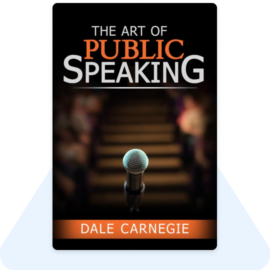










Thankyou so much sir
*be a good listner first
*make connection with the audience
*plan what to say…..